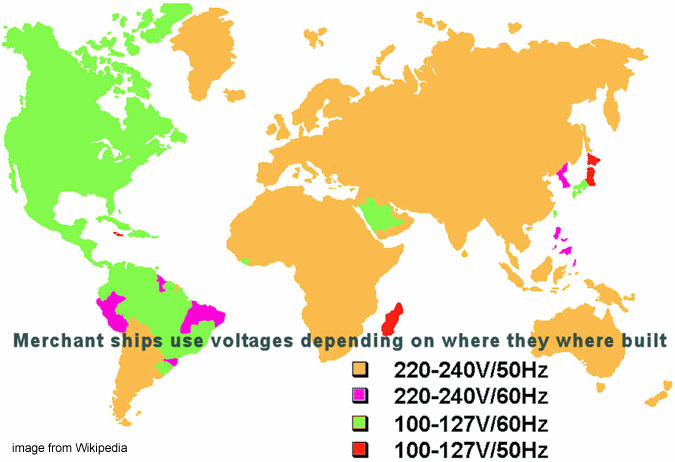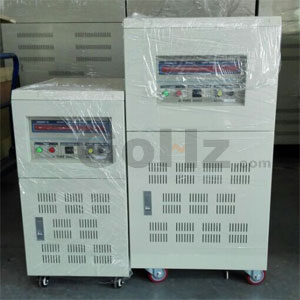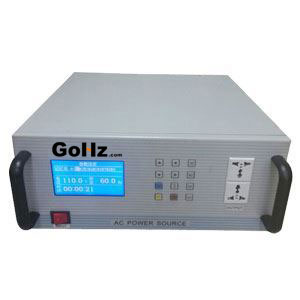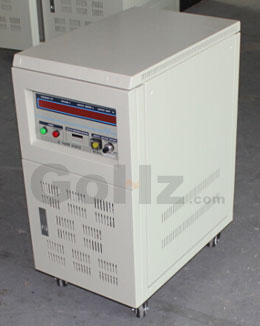What is 50Hz, 60Hz?
50Hz (60Hz) means the rotor of the motor generator turns 50 (60) cycles per second, the current changes 50 (60) times per second back and forth, direction changes 100 (120) times. That means the Volt changes from positive to negative, and from negative to positive voltage, this process converts 50 (60) times/second. The electricity of single phase 110v, 120v, 220v, 240v, and three phase 380v, 400v, 415v, 440v, 460v, 480v AC power, are 50Hz or 60Hz frequencies.The speed of 50Hz (60Hz) 2 poles synchronous motor generator is 3000rpm (3600rpm). AC power frequency is determined by the pole number of the motor generator p and speed n, Hz = p*n/120. The grid standard frequency is 50Hz (60Hz), which is a constant value. For a 2-pole motor, the speed n = 50 * 120 / 2 = 3000rpm (60 * 120 / 2 = 3600rpm); for a 4-pole motor, the speed n = 50 * 120 / 4 = 1500rpm (60 * 120 / 4 = 1800rpm).
Why use 50Hz, 60Hz frequency power supply?
According to the basics, when the frequency increases, the copper and steel consumptions of the generator and transformer decrease, along with the reduction of weight and cost, but will make the inductances of the electrical equipment and transmission line increase, reduce the capacitances and increase losses, thereby reduce the transmission efficiency. If the frequency is too low, the electrical machines' materials will increase, along with heavy and high cost, and will make lights flashing obviously. Practices have proved using 50Hz, 60Hz frequencies are the best for most home/industrial power supplies.
What we supply?
That's not big difference between 50Hz and 60Hz, but it's critical for some appliances, like oven, CD player etc. Hence we are here to supply the Frequency Converter for converting between 50Hz and 60Hz, for both single phase (100v, 110v, 115v, 120v, 220v, 230v, 240v) and three phase (220v, 240v, 380v, 400v, 420v, 440v, 460v, 480v), customize input voltage for different countries' power source, output voltage from 0 to 300v for single phase, 0 to 520v for three phase, frequency for 40.0 Hz to 499.9 Hz.
The world's main supplies electricity (AC) voltages are different from countries to countries, generally are 110V (120V) and 220V (230V, 240V). The operation frequency is typically 60Hz at 110v in USA/Canada while European/Asian countries use 220v 50Hz.
Why did the countries choose the voltage and frequency?
Is there any special case?
What will happen if you use your appliances in other countries?
This article will explain in brief.

Why did the countries choose the voltage and frequency?
Is there any special case?
What will happen if you use your appliances in other countries?
This article will explain in brief.

There is no "best" frequency or voltage. Everything requires some trade-off in performance or manufacturability.
In historically 50 Hz and 60 Hz is relatively same than low frequency 25 Hz or high frequency 133 Hz was appear and in operate. If you have Japan reference, there are use 50 Hz and 60 Hz power supplies with HVDC back To back. In electronic developing, specially some applications use until 400 Hz, see on electrical system Of aircraft and marine.
60 Hz machines tend to operate at slightly higher speeds - or have a slightly more complex mechanical arrangement (more poles) compared to 50 Hz equipment. Is that better or worse? Depends on what is being weighed in the equation.

In historically 50 Hz and 60 Hz is relatively same than low frequency 25 Hz or high frequency 133 Hz was appear and in operate. If you have Japan reference, there are use 50 Hz and 60 Hz power supplies with HVDC back To back. In electronic developing, specially some applications use until 400 Hz, see on electrical system Of aircraft and marine.
60 Hz machines tend to operate at slightly higher speeds - or have a slightly more complex mechanical arrangement (more poles) compared to 50 Hz equipment. Is that better or worse? Depends on what is being weighed in the equation.
Tags: 50Hz vs 60Hz
 Often the European motors at 1hp size are universal for 50Hz or 60Hz power supply, as long as you have 400V x 50Hz and 460V x 60Hz. This is because the voltage curve from 0V x 0Hz is much the same power line through 400 x 50Hz on its way to 460V x 60Hz, so the motor is still fluxed correctly. At 60Hz power source it will usually be capable of increased power, but you will need to refer to the manufacturer's data to confirm this, and how many poles and who is the manufacturer.
Often the European motors at 1hp size are universal for 50Hz or 60Hz power supply, as long as you have 400V x 50Hz and 460V x 60Hz. This is because the voltage curve from 0V x 0Hz is much the same power line through 400 x 50Hz on its way to 460V x 60Hz, so the motor is still fluxed correctly. At 60Hz power source it will usually be capable of increased power, but you will need to refer to the manufacturer's data to confirm this, and how many poles and who is the manufacturer. Another point touched on here, is the pump. Is this a European pump, or are you retrofitting the motor? If the motor and Pump are made for use on 50Hz power supply, then there will be much more power demanded by the load. This is because at 60Hz speed will increase by 20% and absorbed kW follows the 'Cube' of speed (given that nothing else changes).
Tags: 50Hz vs 60Hz
When you buy an 110v (120v) 60Hz appliance from USA, and run it on 220v (230v, 240v) 50Hz country (i.e. UK, Australia, Singapore), besides of a step up transformer, you may need a frequency converter to convert 60Hz to 50Hz. On the market you can buy the frequency converter up to 45kVA. I have an old radio from UK and because of good low basses I still use it with the Hz converter. Still you have to know that there is not standard for receptacles/socket outlets and plugs. Every country has its own sizes. So when you taking the refrigerator from UK to US and it is 600 Watts/230v, this frequency converter can change 110v (120v) 60Hz to 230v 50Hz without additional step up transformer. You can use it worldwide. It doesn't matter of the difference of 50Hz or 60Hz frequency.
Still you have to know that there is not standard for receptacles/socket outlets and plugs. Every country has its own sizes. So when you taking the refrigerator from UK to US and it is 600 Watts/230v, this frequency converter can change 110v (120v) 60Hz to 230v 50Hz without additional step up transformer. You can use it worldwide. It doesn't matter of the difference of 50Hz or 60Hz frequency.
It covered everything what necessary to do for appliance of 110v, 120v and 220v, 230v, 240v. Remember connect with 110v only appliances good for 110v, and connect with 220v the appliances good for 220v. When your appliance is different use special step up transformer 110v (120v) to 220v (230v, 240v) or step down transformer 220v (230v, 240v) to 110v (120v). Also you can use a GoHz frequency converter to convert V & Hz in one time.
 Still you have to know that there is not standard for receptacles/socket outlets and plugs. Every country has its own sizes. So when you taking the refrigerator from UK to US and it is 600 Watts/230v, this frequency converter can change 110v (120v) 60Hz to 230v 50Hz without additional step up transformer. You can use it worldwide. It doesn't matter of the difference of 50Hz or 60Hz frequency.
Still you have to know that there is not standard for receptacles/socket outlets and plugs. Every country has its own sizes. So when you taking the refrigerator from UK to US and it is 600 Watts/230v, this frequency converter can change 110v (120v) 60Hz to 230v 50Hz without additional step up transformer. You can use it worldwide. It doesn't matter of the difference of 50Hz or 60Hz frequency.It covered everything what necessary to do for appliance of 110v, 120v and 220v, 230v, 240v. Remember connect with 110v only appliances good for 110v, and connect with 220v the appliances good for 220v. When your appliance is different use special step up transformer 110v (120v) to 220v (230v, 240v) or step down transformer 220v (230v, 240v) to 110v (120v). Also you can use a GoHz frequency converter to convert V & Hz in one time.
There are some frequency converters that can convert 60Hz to 50Hz, or vice, but it's too costy to be used for home appliances, it would be better if there is an economic way to run 50Hz electrical appliances on 60Hz system.
Well for one thing, the 110v 60Hz electrical appliance will blow the fuse and also the power supply. 220v 50Hz appliance might start up, and burn the PC board as supply voltage is too low for that appliance. It depends upon the nature of the appliance but generally speaking if the voltage is too high it draws too much current and burns out, if the voltage is too low it draws too little current and/or does not perform to its rating. The mathematical reference is Ohm's Law and the Power Triangle.
Well for one thing, the 110v 60Hz electrical appliance will blow the fuse and also the power supply. 220v 50Hz appliance might start up, and burn the PC board as supply voltage is too low for that appliance. It depends upon the nature of the appliance but generally speaking if the voltage is too high it draws too much current and burns out, if the voltage is too low it draws too little current and/or does not perform to its rating. The mathematical reference is Ohm's Law and the Power Triangle.
 Since the formula for governing the synchronous speed of a three-phase motor is = [(120* Hz)/# Motor Poles] if this is a 4-pole motor then at 50 Hz the speed would be 1500 RPM whereas at 60 Hz the speed would be 1800 RPM. Since motors are constant torque machines then by applying the formula that HP = (torque*RPM)/5252 then you can see that with a 20% increase in speed the motor would also then be able to produce 20% more horsepower. The motor would be able to produce rated torque at both frequencies only apply if the V/Hz ratio is constant, meaning that at 50 Hz the supply voltage would need to be 380V and at 60 Hz the supply voltage would need to be 460V. In both cases the V/Hz ratio is 7.6 V/Hz.
Since the formula for governing the synchronous speed of a three-phase motor is = [(120* Hz)/# Motor Poles] if this is a 4-pole motor then at 50 Hz the speed would be 1500 RPM whereas at 60 Hz the speed would be 1800 RPM. Since motors are constant torque machines then by applying the formula that HP = (torque*RPM)/5252 then you can see that with a 20% increase in speed the motor would also then be able to produce 20% more horsepower. The motor would be able to produce rated torque at both frequencies only apply if the V/Hz ratio is constant, meaning that at 50 Hz the supply voltage would need to be 380V and at 60 Hz the supply voltage would need to be 460V. In both cases the V/Hz ratio is 7.6 V/Hz.A potential solution for this problem would be to apply a variable frequency drive in this application which would be able to take in the 460V/60 Hz power source and output 380V/50Hz to the motor, putting everything back to the original design.
Electric motors, both single and three phase, are designed for running on a specified power frequency. But sometimes we may use a 'wrong' motor on the power supply.

The basic, RPM is in direct proportion to Hz. If you decrease the power supply frequency, the motor will slow down. On the contrary, if you increase the frequency, the motor will speed up. The RPM change is proportional to the Hz change.
60Hz motor will run 20% slower on 50Hz power supply
This also results in 20% less power. Basically, running the electric machine slower usually means it will be demanding less power. That's good, as the motor also decrease 20% of its power, and the cooling fan is slow down too. But the critical factor here is the V/Hz ratio. It goes up 20%! Not good. This means that during parts of every power line cycle the magnetic structure of the motor will probably be overloaded.
The only recourse here is to correct the V/Hz with the variable value that is easy to change – V the voltage. Lower the voltage with a transformer to correct the V/Hz ratio.

The basic, RPM is in direct proportion to Hz. If you decrease the power supply frequency, the motor will slow down. On the contrary, if you increase the frequency, the motor will speed up. The RPM change is proportional to the Hz change.
60Hz motor will run 20% slower on 50Hz power supply
This also results in 20% less power. Basically, running the electric machine slower usually means it will be demanding less power. That's good, as the motor also decrease 20% of its power, and the cooling fan is slow down too. But the critical factor here is the V/Hz ratio. It goes up 20%! Not good. This means that during parts of every power line cycle the magnetic structure of the motor will probably be overloaded.
The only recourse here is to correct the V/Hz with the variable value that is easy to change – V the voltage. Lower the voltage with a transformer to correct the V/Hz ratio.
You can use 50Hz instead of 60Hz, here in my country the frequency is 60Hz and is very common that IEC (50Hz) motors work here without troubles. IEC motor frequency has been made oversize so the flux, warm or other factors in DOL will not be affected. Probably for a smaller motor it's yes. A larger one might not be able to handle the mechanical and electrical stresses at 60Hz.
You must consider the additional speed and make sure you do not exceed the HP/current rating. With a variable torque pump the load could go up by as much as 72% (60/50^3) rpm will change, for example at 60 Hertz will produce 3600 rpm,1800 rpm, 1200 rpm, 900 rpm. The number of poles is always in pairs. at 50 hertz, 3000 rpm, 1500 rpm, so on.
You must consider the additional speed and make sure you do not exceed the HP/current rating. With a variable torque pump the load could go up by as much as 72% (60/50^3) rpm will change, for example at 60 Hertz will produce 3600 rpm,1800 rpm, 1200 rpm, 900 rpm. The number of poles is always in pairs. at 50 hertz, 3000 rpm, 1500 rpm, so on.
Tags: 50Hz vs 60Hz
An induction motor at 0.75 kW (approx. 1 HP), 50 Hz, 400v AC, set the motor Hz in the VFD to 60, then the Motor Voltage to 480v AC. This will increase the motor output to approx. 0.9 kW, (approx. 1.2 HP) with a corresponding increase in torque. Setting the motor speed (RPM) using the 20% factor is also essential. For example, if the motor speed @ 50 Hz is 1,400 RPM, dividing the RPM total by 0.8, results in a quotient of 1,750 RPM. By affording this balance of the Volts/Hz/RPM ratio, the equipment design criteria is very closely matched in the conversion.
In the US, the power grid is not as uniform as it is in many areas of Europe and elsewhere, with voltage levels fluctuating significantly from grid to grid. These levels will vary from approx. 460 VAC to 490 VAC in most areas in Wye Delta supply. In Grounded Delta (aka 'B' Phase Delta) the line variances can spread from 440 VAC to 525 VAC, depending on the power grid source and how many facilities draw power simultaneously along that grid supply.
In the US, the power grid is not as uniform as it is in many areas of Europe and elsewhere, with voltage levels fluctuating significantly from grid to grid. These levels will vary from approx. 460 VAC to 490 VAC in most areas in Wye Delta supply. In Grounded Delta (aka 'B' Phase Delta) the line variances can spread from 440 VAC to 525 VAC, depending on the power grid source and how many facilities draw power simultaneously along that grid supply.
50Hz 60Hz Frequency Converter Setting
Using GoHz frequency converter to
Or customize your own converters.
- Convert 220v 50Hz to 110v 60Hz,
- Convert 120v 60Hz to 230v 50Hz,
- Convert 110v 60Hz to 240v 50Hz,
- Convert 480v 60Hz to 380v 50Hz,
- Convert 400v 50Hz to 460v 60Hz,
- Convert 240v 60Hz to 380v 50Hz,
Or customize your own converters.
Featured Articles
460v 60Hz motor on 400v 50Hz power ...
 Often the European motors at 1hp size are universal for 50Hz or 60Hz power supply, as long as you have 400V x 50Hz and 460V x ...
Often the European motors at 1hp size are universal for 50Hz or 60Hz power supply, as long as you have 400V x 50Hz and 460V x ...
 Often the European motors at 1hp size are universal for 50Hz or 60Hz power supply, as long as you have 400V x 50Hz and 460V x ...
Often the European motors at 1hp size are universal for 50Hz or 60Hz power supply, as long as you have 400V x 50Hz and 460V x ...Convert 220v, 230v, 240v 50Hz to 110v, ...
 When you buy an 110v (120v) 60Hz appliance from USA, and run it on 220v (230v, 240v) 50Hz country (i.e. UK, Australia, ...
When you buy an 110v (120v) 60Hz appliance from USA, and run it on 220v (230v, 240v) 50Hz country (i.e. UK, Australia, ...
 When you buy an 110v (120v) 60Hz appliance from USA, and run it on 220v (230v, 240v) 50Hz country (i.e. UK, Australia, ...
When you buy an 110v (120v) 60Hz appliance from USA, and run it on 220v (230v, 240v) 50Hz country (i.e. UK, Australia, ...60Hz motor running on 50Hz power ...
 Electric motors, both single and three phase, are designed for running on a specified power frequency. But sometimes we may use a ...
Electric motors, both single and three phase, are designed for running on a specified power frequency. But sometimes we may use a ...
 Electric motors, both single and three phase, are designed for running on a specified power frequency. But sometimes we may use a ...
Electric motors, both single and three phase, are designed for running on a specified power frequency. But sometimes we may use a ...